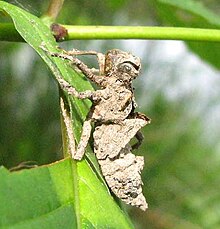
Back Eksoskelet Afrikaans هيكل خارجي (أحياء) Arabic Экзашкілет (біялогія) Byelorussian Външен скелет Bulgarian Ezrelegenn Breton Egzoskelet BS Exoesquelet Catalan Vnější kostra Czech Exoskelet Danish Exoskelett German


An exoskeleton (from Greek έξω éxō "outer"[1] and σκελετός skeletós "skeleton"[2][3]) is a skeleton that is on the exterior of an animal to both support the body shape and protect the internal organs, in contrast to an internal endoskeleton (e.g. that of a human) which is enclosed underneath other soft tissues. Some large, hard and non-flexible protective exoskeletons are known as shell or armour.
Examples of exoskeletons in animals include the cuticle skeletons shared by arthropods (insects, chelicerates, myriapods and crustaceans) and tardigrades, as well as the outer shell of certain sponges and the mollusc shell shared by snails, clams, tusk shells, chitons and nautilus. Some vertebrate animals, such as the turtle, have both an endoskeleton and a protective exoskeleton.
- ^ Liddell, Henry George; Scott, Robert (1940). "ἔξω". A Greek-English Lexicon. Perseus Digital Library.
- ^ Liddell, Henry George; Scott, Robert (1940). "σκελετός". A Greek-English Lexicon. Perseus Digital Library.
- ^ Douglas, Harper (2001). "exoskeleton". Online Etymology Dictionary. Archived from the original on 20 April 2013.